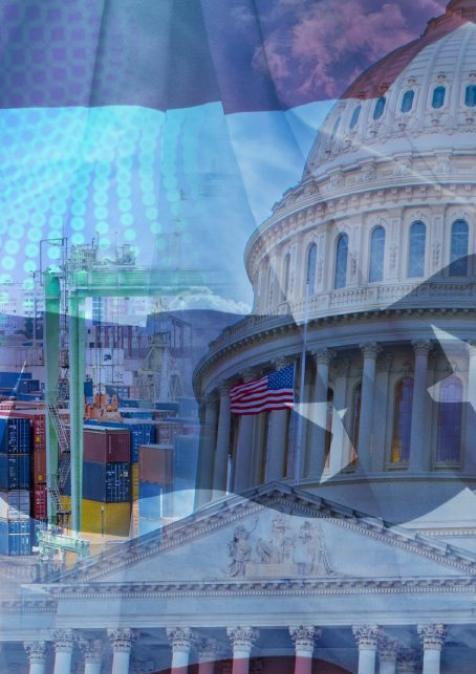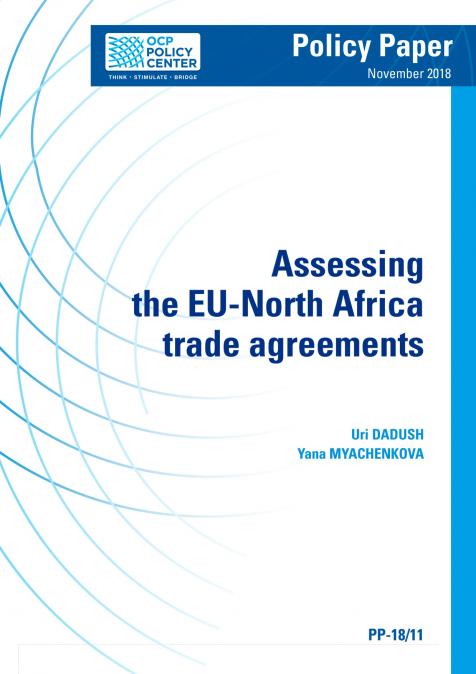Publications /
Opinion
The best way I can describe my feelings about trade these days is as an unstable anxiety disorder. Following on November 8 2016, the date of the US election, my anxiety level rose markedly as the Trans-Pacific Partnership (TPP) was buried. Shortly thereafter it touched a maximum when a dangerous idea called the Border Adjustment Tax was gaining traction, and the North-American Free Trade Agreement seemed headed the way of TPP. Then I became a little less prone to panic attacks, as various checks and balances on Presidential action seemed to kick in. Executive Orders now command the preparation of studies of why trade agreements are not working instead of commanding immediate departure from them. That gives me hope.
Sunday evening, I felt really good. Even France, my country – whose sons in the 16th century were among the originators of mercantilism – a doctrine that has lost none of its allure over the centuries, elected a President who embraces globalization. Despite Brexit and the rise of right wing nationalist parties, the European Union – the world’s largest trading block – is not about to break up. Not yet.
I am not alone in feeling a certain peace of mind. Not only are stock markets booming, but the VIX index, which evaluates anxiety in the financial markets quite precisely by measuring the cost of hedging bets, has reached the lowest level since 1993, the year before the Uruguay Agreement which launched the WTO was concluded. The IMF ‘s forecast for the world economy over 2017 and 2018 calls for 3% growth (at market exchange rates), which is essentially the 25-year pre-crisis average. After many years of subpar growth – due mainly to cyclical factors - world trade growth is projected at 4% a year, much slower than the pre-crisis average but still well above GDP growth.
So, should we still worry? The answer is yes. First, as we have seen in the last 24 hours, Washington is full of surprises. Second, because the Administration is proposing tax cuts, and a shift towards increased infrastructure and defense spending, which -if cleared by Congress - together will amount to a substantial fiscal stimulus. This is likely to occur against a background of full employment, rising interest rates, and a strong dollar, and is a textbook recipe for an increase in its trade deficit in 2018 and beyond. The big bilateral trade deficits with China, Germany, Japan and Mexico that the Administration does not like are likely to become quite a bit larger instead of smaller. Something will have to give, and that something could turn out to be open markets. Third, because little is being done to address the root cause of the new protectionism, namely the rise in inequality and the falling behind of less-skilled workers. In fact, US fiscal, health-care, education and regulatory policies are currently oriented to increase, not reduce inequality. Given the prospect of continued far-reaching labor-saving technological change, such as self-driving cars, I am ready to bet that the opposition to trade will intensify in coming years, even when it is not trade that is the real problem.
So, we are not out of the woods. The risk of a major trade backlash is still very much with us, and the state of the world trading system must be assessed against this rather inauspicious background.
The issues confronting the WTO have been widely discussed and are well known. In essence, with the stall of the Doha negotiations, which were launched over 15 years ago (I was there, full of hope!) it became evident that the mechanism that generated waves of trade liberalization in 8 previous multilateral trade rounds under the GATT has broken down. The WTO settles trade disputes but is allegedly losing its relevance because it is not able to adapt its rules and disciplines to the needs of the time. While the Bush and Obama Administrations at least continued to pay lip service to the value of the organization and even tried to revive it, the Trump administration is challenging it frontally.
Commerce Secretary Wilbur Ross and USTR nominee Robert Lighthizer have both, in different contexts, complained about the WTO’s dispute settlement system as being biased against the United States, and as inappropriately creating rules which could not be negotiated by setting judicial precedent. Mr. Lighthizer has argued that the US is not legally bound by WTO rulings. Mr. Ross has argued that whereas the United States has bound its tariffs at very low levels, many of its trading partners have not, and that this puts the US at a big disadvantage and helps explain its large bilateral trade deficit with so many countries. Economists who believe that bilateral trade deficits don’t mean much in an integrated world, and that the aggregate US trade deficit is due to a deficiency of national savings and/or the desire of foreigners to invest in the United States don’t seem to get much of a hearing. Mr. Ross has also argued, correctly, that the WTO does not do enough to impede non-tariff barriers. He has also argued that the Value-Added Tax, adopted by nearly all other WTO members, discriminates against US exports and in effect subsidizes the exports of other countries. This latter claim is factually incorrect but the myth persists.
The President even threatened to withdraw from the WTO during the campaign, and – while any such move may be challenged in the courts - legal scholars believe that the President of the United States has the legal authority – delegated by Congress – to exit from any trade agreement, including the WTO, with 6 months’ notice.
How likely is the US to withdraw from the WTO? I believe it is conceivable but very unlikely. The blow to the United States’ prestige and the indirect effect on national security would be immense. But more concrete is the enormous stake that the United States has in its export industries and in investment overseas, all of which, to a greater or lesser extent rely on the openness and predictability of trade under WTO rules. The ability of agricultural, automobile, high-tech, and pharmaceutical industries to name a few to influence the Republican Congress is considerable; states that rely most heavily on exports, such as Texas, hold key positions in committees that deal with trade. Presumably, the US would withdraw from the WTO to raise tariffs. This would also be resisted by retailers and producers that rely on imports, as already seen in the case of the Border Adjustment Tax. When the US enacted the Smoot-Hawley tariffs that led to a global trade war in the 1930’s, the nation was in depression, not at full employment as today, and trade as a share of national income was about one-third of today. And there were no comparable WTO and bilateral trade agreements that bind the United States today.
The US is unlikely to withdraw from the WTO, but the prospects of 4 or 8 years of immobility in the institution are now almost assured. How should the WTO react and what should its largest members, the EU, China and Japan do?
To start, the WTO needs to recognize that Doha is dead and that the all- encompassing-single- undertaking–160 country approach to negotiations does not work. Instead, negotiating modalities need to revolve around specific issues that a critical mass of countries care deeply about – so called plurilaterals. These should go forward whether or not all WTO members want to participate. In some instances, the rules should allow non-participants to derive the benefit of the agreement without taking on its obligations, while in others this free-riding should be preventable. Various non-tariff barriers should be near the top of the list to be addressed by plurilaterals. The Bali Trade Facilitation agreement did this for customs procedures. It was billed as multilateral but in practice had so many flexibilities built -in for developing countries that it is close to being a plurilateral agreement.
The organization also needs a new narrative, a narrative that is highly credible because grounded in facts. True, the 23 years since the WTO was created did not see a big multilateral deal. But they did see great advances in freer trade through regional and bilateral deals, and unilateral liberalization, all of which depended directly or indirectly on WTO rules and disciplines. For example, the starting point of any bilateral deal are applied MFN tariffs in the WTO. For example, if Britain leaves the EU without a trade deal, it will not wander for 40 years in the desert, but it will revert to WTO disciplines. The WTO itself has made enormous strides in its capacity to regulate world trade. The accession to the institution under Article 22 of China and 35 other members expanded its coverage from some 80% to some now 98% of world trade; 21 more countries are in the process of accession. Even more importantly, the accession process, long and laborious as it is, anchored China’s market reforms and that of all the other Article 22 countries. Effectively applied tariffs in China, the US, the EU, Japan and in many developing countries have come down very significantly since 1994 even in the absence of a global deal. They are now very close to zero in advanced countries and this is an important reason why trade deals are not as compelling as they used to be – there is simply less to bargain over. Some 500 disputes have been settled at the WTO – making a huge contribution to maintaining orderly economic relations. Developing countries, including the smallest and poorest in Africa, now have recourse against the policies of the most powerful players. Despite the global financial crisis, protectionist measures have so far affected only some 5% of world trade, and even then, in most instances the effect has been minuscule.
There are five policy implications from this short review: 1. The WTO must change its negotiating modalities towards plurilaterals and address non-tariff barriers more effectively 2. The European Union, China and Japan must work together to ensure the WTO’s health and continuity while encouraging the United States to remain in the fold 3. Developing countries, including the poorest in Africa, arguably have the most to lose from a weakened WTO and must also raise their game in the institution 4. American firms that depend on foreign trade and investment must realize that weakening the WTO makes them far more vulnerable to unfair trade practices, not less vulnerable, and they make their voices heard and 5. All countries, beginning with the United States, need to reexamine the internal dynamics that caused the new protectionism. They must address increased inequality and marginalization through social policy, instead of choking trade or technology which are the wellspring of our prosperity.







